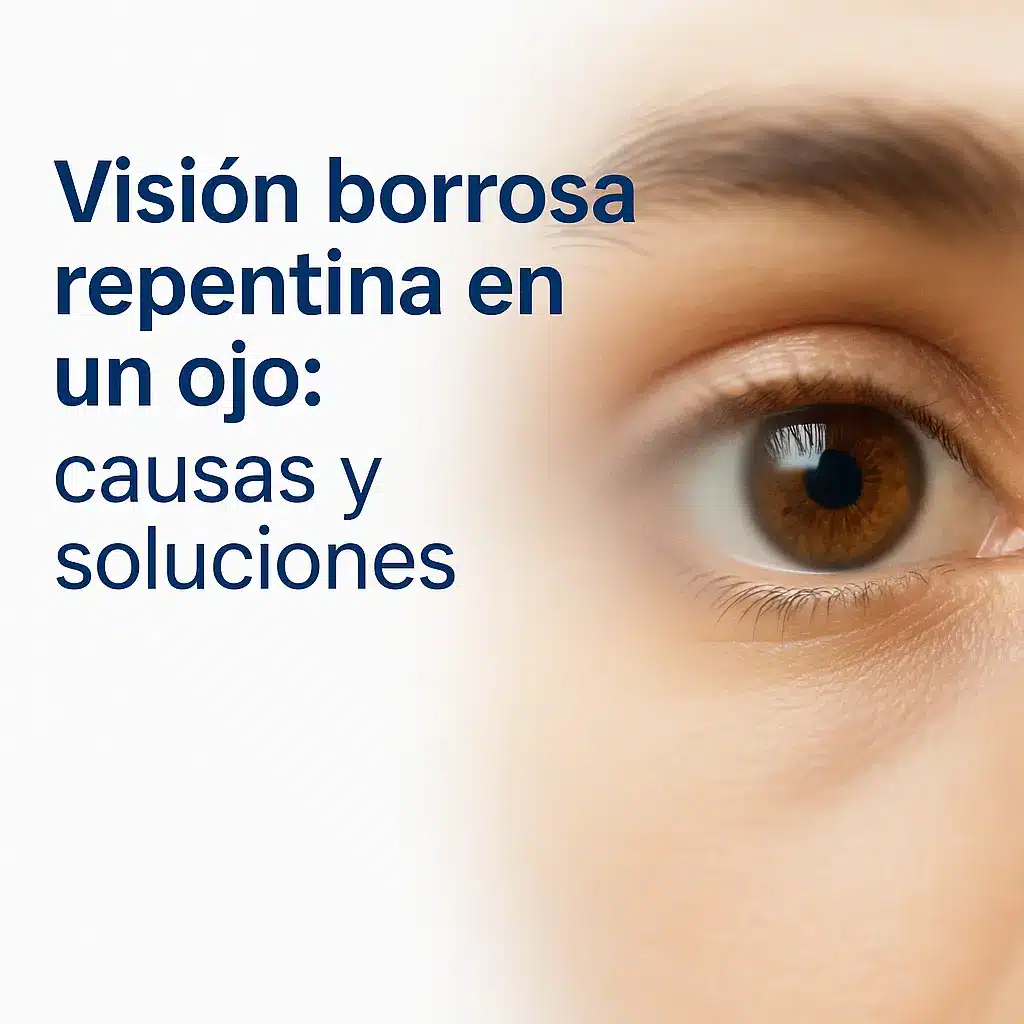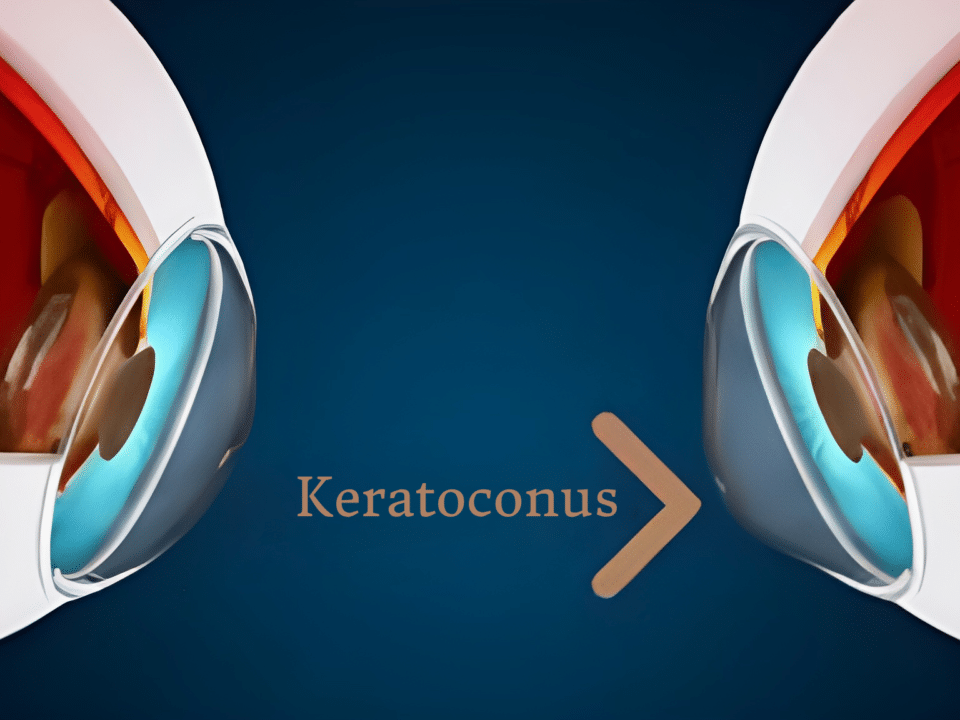Have you suddenly noticed that your vision is blurring in one eye and you feel worried? This symptom may be temporary or the first warning of an eye problem that needs attention. Here you'll find out what can cause it, how it's diagnosed with advanced technology and what personalised solutions are available to you.
Causes of Sudden Blurred Vision in One Eye
Sudden blurred vision can be caused by a number of factors:
- Eye fatigue and prolonged screen use.
- Evaporative ocular dryness that causes micro-irregularities on the corneal surface.
- Migraines with visual aura.
- Accommodation spasm due to continuous near vision tasks.
- Glaucoma angle-closure eye disease (ophthalmological emergency).
- Injuries to the cornea or foreign bodies.
- Myodesopsias (hoverflies).
- Vascular problems of the optic nerve.
- Retinal detachment or pathologies of the macula.
- Hormonal changes, especially during pregnancy.
Each cause has unique characteristics that may influence the EYE HEALTH. The main causes that can lead to this symptom are discussed below.
Eye Fatigue and Screen Use
The eye fatigue is a common cause of blurred vision. Prolonged exposure to electronic devices, such as computers and mobile phones, causes significant strain on the eye muscles. This results in a lack of sharpness and can be accompanied by discomfort such as dryness and redness of the eye.

Dry Eye Problems
Dry eye occurs when there is insufficient tear production or excessive evaporation. This affects visual clarity and can lead to episodes of blurred vision. Environmental factors, such as air-conditioned environments, intensify dry eyes.
In addition, the dry eyes can generate micro-irregularities on the surface of the cornea, contributing to visual distortions not correctable with conventional spectacles, related to higher order aberrations (HOA).
Migraines and Other Associated Symptoms
The migraines are often responsible for alterations visuals. During a migraine episode, some people experience symptoms such as flashes of light or blurred vision. These visual phenomena, known as aura, may be transient and usually resolve with the cessation of the headache.
Accommodation Spasm
This phenomenon occurs when the eye muscles contract abnormally, making it difficult to focus. It is common in individuals who perform near vision tasks for prolonged periods of time, resulting in temporary blurred vision at times.
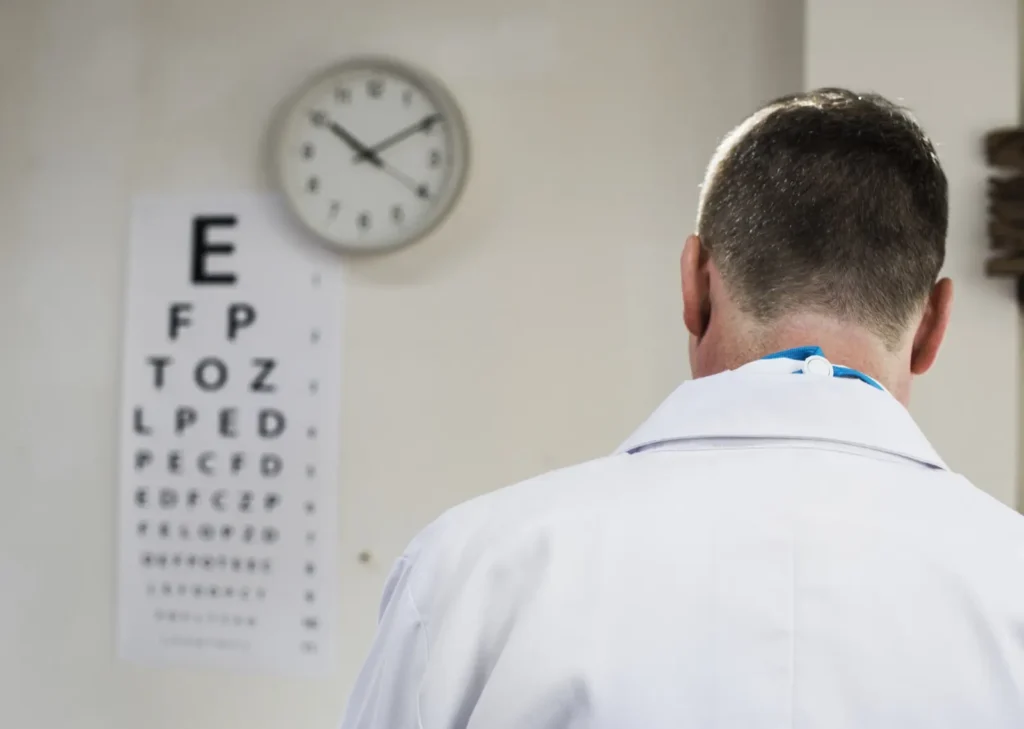
Closed Angle Glaucoma
A more serious condition that can cause sudden blurred vision is angle-closure glaucoma. This sudden increase in intraocular pressure causes symptoms such as severe pain and can lead to vision loss if not treated urgently.
In these cases, see an ophthalmologist with experience in glaucoma surgery as Dr. Ali Nowrouzi can be key to avoiding complications and preserving vision.
Corneal Lesions and Dry Eye
Corneal injuries, whether from a foreign body or abrasions, can result in immediate blurred vision. These need urgent medical attention to avoid further complications, such as infection or permanent damage to the cornea.
Myodesopsia and Hoverflies
The myodesopsias, o "eye floaters"are small dark spots floating in the field of vision. Although generally harmless, their sudden appearance in large numbers can cause uneasiness and an altered perception of vision.
Optic Nerve Vascular Problems
Circulatory problems affecting the optic nerve can lead to sudden blurred vision. Lack of blood supply may be the result of underlying conditions, such as hypertension, which requires immediate medical attention.
Hormonal Changes and Vision During Pregnancy
Pregnant women may experience hormonal changes that affect your vision. These changes can result in episodes of blurred vision, although they are usually transient and usually resolve after pregnancy.

Higher-order aberrations: a hidden cause of blurred vision
A common but little understood reason for persistent blurred vision is an increase in higher order aberrations (HOA), which cause image distortions that cannot be corrected with conventional spectacles.
These aberrations may be due to
Alterations on the ocular surface due to dry eye.
✅ Corneal scars.
✅ Corneal irregularities after previous surgeries.
Occult corneal pathologies such as keratoconus in early stages.
The keratoconusfor example, can go unnoticed in the early stages, manifesting only as blurred or fluctuating vision and increased astigmatism, and early detection is essential to prevent progression.
Diagnosis of Sudden Blurred Vision
Proper diagnosis of the sudden blurred vision is essential to identify its cause and determine the most appropriate treatment. Various tests are carried out that allow the specialist to assess eye health in a comprehensive manner.
Fundus Examination
This procedure is essential for viewing the retina and optic nerve. During the examination, the ophthalmologist uses an ophthalmoscope to illuminate the inside of the eye for a detailed assessment. This examination can reveal pathologies such as:
- Retinal detachment.
- Macular conditions.
- Vascular alterations.
Early detection of these conditions can be crucial to prevent permanent vision damage.
In the Dr. Nowrouzi's clinicThis type of assessment is carried out using advanced technology to ensure an accurate and personalised diagnosis.
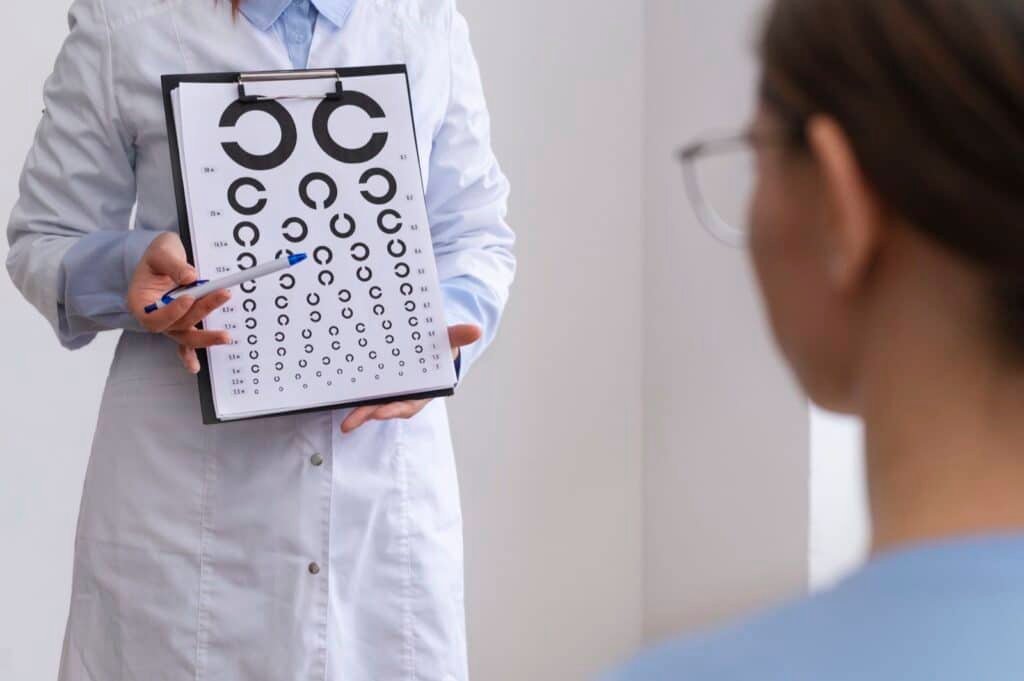
Tonometry: Intraocular Pressure Measurement
The tonometry is a test that measures the pressure inside the eye, a determining factor in the diagnosis of glaucoma. An increase in this pressure may be related to various eye conditions. There are different methods to perform this test, such as:
- Flattening tonometer.
- Air puff tonometer.
The measurement of intraocular pressure allows the ophthalmologist assess the potential risk of glaucoma and other eye abnormalities that could lead to blurred vision.
Visual Acuity Tests
Visual acuity tests are used to assess the degree of clarity of vision. These tests often involve the use of charts or letters to measure the patient's ability to see at different distances. The tests can provide valuable information about:
- Refractive errors, such as myopia or hyperopia.
- Alterations in visual perception due to ocular pathologies.
Assessing visual acuity is a critical step in the diagnostic process and can help determine the most appropriate treatment approach.
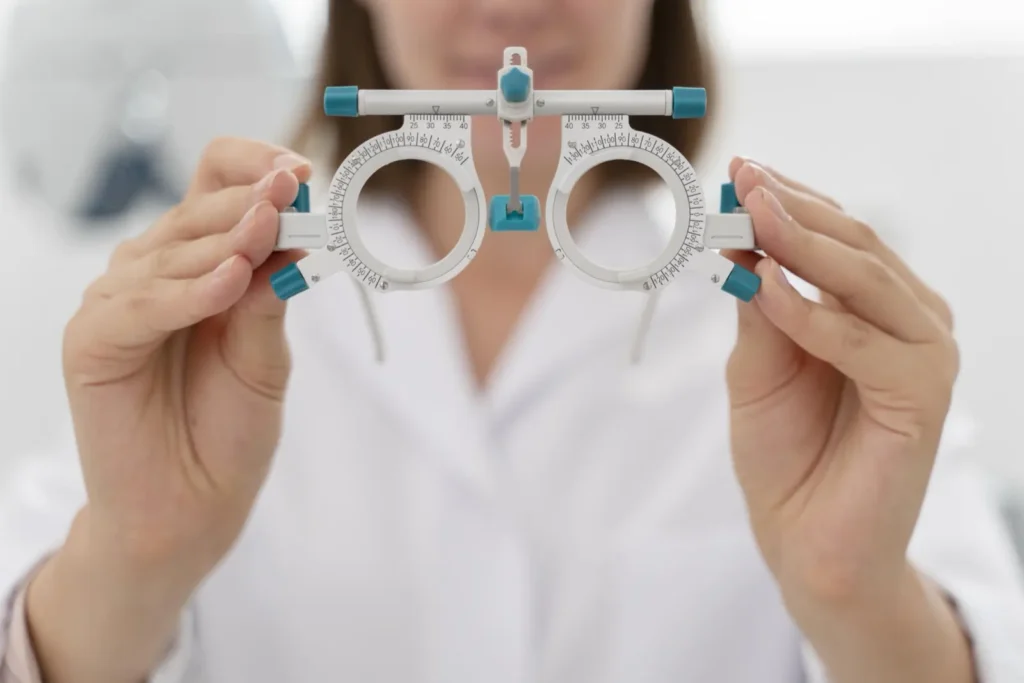
Advanced Diagnostics with Premium Technology
To accurately identify the cause of blurred vision, we perform an advanced diagnostic protocol, which includes:
Advanced corneal topography (Sirius® and Keratograph®): to detect corneal irregularities and early signs of keratoconus.
High-definition OCT epithelial mapping: allows the study of epithelial thickness variations, a sensitive indicator of incipient keratoconus and surface pathologies.
🔹 Corneal and total ocular aberrometry: measures higher order aberrations responsible for difficult-to-correct blurred vision.
TearLab® and Keratograph® for dry eye and tear quality studies.
Schirmer test and tear osmolarity.
🔹 Tomography and OCT angiography of retina and macula: to rule out retinal causes of blurred vision.
Tonometry to measure intraocular pressure and rule out acute glaucoma.
🔹 Detailed fundus examination.
Thanks to this combination of advanced tests, we can identify hidden causes of blurred vision that go undetected in conventional examinations.
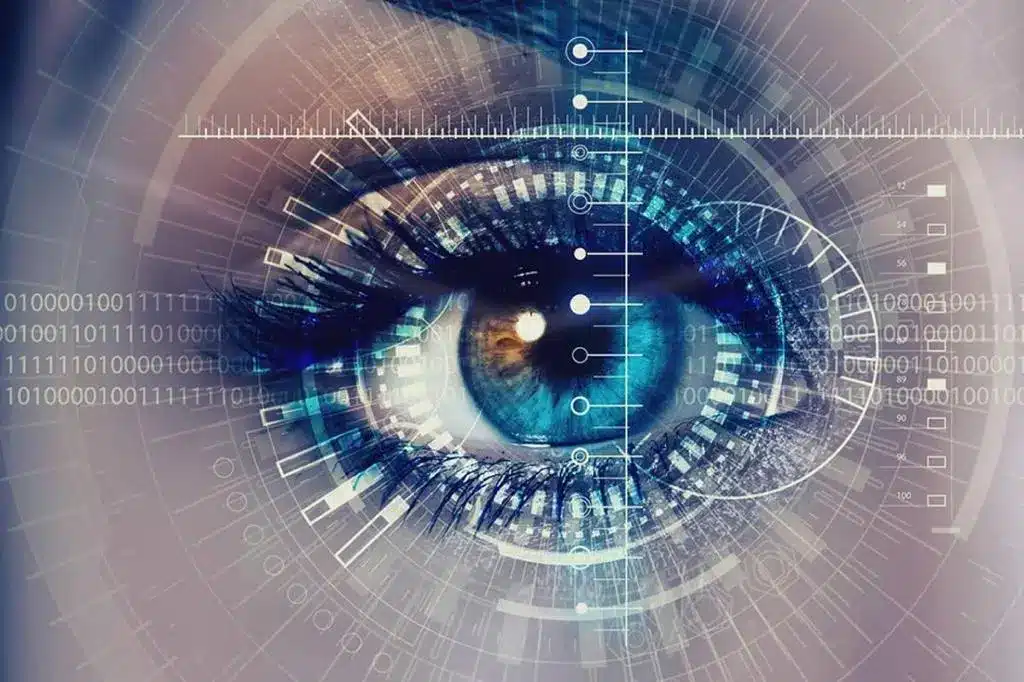
Treatments for Blurred Vision
Management of blurred vision involves a variety of strategies depending on the underlying cause and severity of the symptom. The following explores the most common treatments that facilitate recovery and improvement of eye health.
Strategies for Refractive Errors
Refractive errors are one of the most common causes of blurred vision. Their treatment usually consists of optical corrections.
Use of Glasses and Contact Lenses
Glasses and contact lenses are effective solutions to correct refractive problems. They allow the patient to obtain sharper and clearer vision. The type and prescription of these devices must be adjusted according to each person's vision. It is important to have regular check-ups to avoid uncomfortable prescription errors.
Refractive Surgery as a Permanent Solution
The refractive surgeryLASIK, such as LASIK or PRK, is used to reshape the cornea. This approach aims to reduce or eliminate dependence on glasses or contact lenses. Interventions are generally safe and effective, although it is essential to assess the candidate's suitability through a thorough eye examination.
If you are looking for a definitive solution to blurred vision, Dr. Nowrouzi offers customised refractive surgery with advanced technology to ensure safe and accurate results.
Management of Acute Glaucoma
Acute glaucoma can cause sudden blurring of vision and requires immediate medical attention. Initial treatment includes antihypertensive drugswhich help to reduce intraocular pressure. In some cases, urgent surgery may be necessary to prevent further damage to the optic nerve and preserve vision.
Retinal Detachment Treatment
The detachment of retina is a ophthalmic emergency. Your treatment may include surgery to reattach the retina. There are multiple surgical techniques such as vitrectomy or application of a silicone band. Timely intervention is crucial to minimise vision loss and improve visual outcomes.
Advanced Treatments according to Diagnosis
- Refractive errors (myopia, hyperopia, astigmatism)Correction with glasses, contact lenses or personalised refractive surgery with the latest generation laser, guaranteeing safety and precise results thanks to previous topography and aberrometry studies.
- High order aberrationsTreatment with customised refractive surgery technologies or management with special contact lenses.
- Evaporative dry eyeAdvanced therapies such as IPL (Intense Pulsed Light), radiofrequency, sonomed Meibomian gland resonance and pharmacological treatments to improve tear quality.
- Retinal and macular pathologiesEarly detection and referral to specialised treatment.
- Acute glaucomaImmediate management with intraocular pressure reduction and, if necessary, surgery.
- Incipient keratoconusMonitoring, special contact lenses or corneal crosslinking to slow progression.
Prevention of Vision Problems
Preventing visual problems is essential to maintain good eye health over time. Implementing healthy habits can significantly contribute to reducing the incidence of disorders such as blurred vision. Some effective strategies are described below.
Vision Breaks and Prevention of Eye Fatigue
Eye fatigue is a common problem, especially in the digital age. An effective method to combat it is to take regular breaks. It is suggested that the rule 20-20-20, which consists of looking at something 20 feet (6 metres) away for at least 20 seconds every 20 minutes of screen work. This helps to relax the eye muscles and improve concentration.
Eye Hygiene and Use of Artificial Tears
Eye hygiene should not be overlooked. Keeping eyes clean can prevent infection and improve visual comfort. The use of artificial tears is beneficial in situations of dry eyes, especially in air-conditioned or heated environments. These tears help to restore the tear film and keep the eyes hydrated.
Periodic Ophthalmological Check-ups
Regular check-ups with an ophthalmologist are crucial to detect vision problems early. During these visits, comprehensive eye health assessments will be carried out, allowing any irregularities to be identified before they become a threat to vision. Annual check-ups are recommended, especially for those with a family history of vision problems.
You can book your eye examination easily at dralinowrouzi.com and keep your eye health under control with the peace of mind of being in the hands of a specialist.
Impact of Lifestyle on Eye Health
A healthy lifestyle can have a major impact on eye health. Maintaining a balanced diet rich in antioxidants, such as vitamins C and Eand minerals such as zincpromotes eye health. Regular physical activity also helps to improve blood circulation, which benefits eye health.
- Avoid smoking, as it is associated with an increased risk of eye disease.
- Protect eyes from excessive exposure to sunlight by wearing sunglasses with UV protection.
- Limit screen time, especially for prolonged periods.
Incorporating these practices into daily routines can result in significant long-term eye health benefits.
Frequently asked questions
When is it urgent to see an ophthalmologist for sudden blurred vision?
If blurred vision comes on suddenly and is accompanied by severe eye pain, flashes of light, loss of vision, double vision, severe headache or nausea, you should go immediately as these may be signs of acute glaucoma or retinal detachment.
Does sudden blurred vision always indicate a serious problem?
Not always. It may be due to minor causes such as eye fatigue or dryness, but also to pathologies that require attention. Therefore, if blurred vision persists, is intermittent or appears suddenly, it is important to have a complete ophthalmological examination.
Can dry eyes cause sudden blurred vision?
Yes, lack of tears or poor quality tear film can lead to blurred vision, especially after prolonged use of screens or in air-conditioned environments.
What tests are performed to diagnose the cause of blurred vision?
Tests such as visual acuity, fundus examination, tonometry, corneal topography, macular and retinal OCT, and in some cases aberrometry are performed to detect irregularities not visible in basic check-ups.
Can vision be restored after an episode of blurred vision?
It will depend on the cause. In most cases, with proper diagnosis and correct treatment, vision can be restored or significantly improved.
Can keratoconus cause sudden blurred vision?
In its early stages, keratoconus can cause blurred or fluctuating vision and increased astigmatism. Early detection is key to applying treatments to slow its progression.
Where can I have an advanced vision test if I have blurred vision?
At dralinowrouzi.com you can book your full assessment with advanced technology and a personalised diagnosis to accurately identify the cause of your blurred vision.
References
For more information on the causes and solutions of sudden blurred vision in one eye, please see the following quality links:
- Angle-closure glaucoma:
- Glaucoma: MedlinePlus medical encyclopedia: https://medlineplus.gov/spanish/ency/article/001620.htm
- What is chronic angle-closure glaucoma? - American Academy of Ophthalmology: https://www.aao.org/salud-ocular/enfermedades/que-es-el-glaucoma-cronico-de-angulo-cerrado
- Retinal detachment:
- Retinal detachment - Symptoms and causes - Mayo Clinic: https://www.mayoclinic.org/es/diseases-conditions/retinal-detachment/symptoms-causes/syc-20351344
- Retinal detachment. Causes and treatment - ICR: https://icrcat.com/enfermedades-oculares/desprendimiento-de-retina/
- Keratoconus:
- Keratoconus - Symptoms and causes - Mayo Clinic: https://www.mayoclinic.org/es/diseases-conditions/keratoconus/symptoms-causes/syc-20351352
- Keratoconus: MedlinePlus medical encyclopedia: https://medlineplus.gov/spanish/ency/article/001013.htm
- Myodesopsia (hoverflies):
- Myodesopsias (Floaters) - Ophthalmic Disorders - Merck Manual Professional Version: https://www.merckmanuals.com/es-us/professional/trastornos-oft%C3%A1lmicos/s%C3%ADntomas-de-los-problemas-oft%C3%A1lmicos/miodesopsias-moscas-volantes
- Flying flies and flashes of light - Clínica Universidad de Navarra: https://www.cun.es/enfermedades-tratamientos/enfermedades/moscas-volantes
- Spasm of accommodation:
- Spasm of accommodation - Medical dictionary - Clínica Universidad de Navarra: https://www.cun.es/diccionario-medico/terminos/espasmo-acomodacion
- Unilateral accommodative spasm: a case report - Elsevier: https://www.elsevier.es/es-revista-archivos-sociedad-espanola-oftalmologia-296-articulo-espasmo-acomodacion-unilateral-descripcion-un-S0365669119300425
- Dry eyes:
- Dry eyes - Symptoms and causes - Mayo Clinic: https://www.mayoclinic.org/es/diseases-conditions/dry-eyes/symptoms-causes/syc-20371863
- Dry eye - Causes, Symptoms and Treatments - Barraquer: https://www.barraquer.com/patologia/ojo-seco

